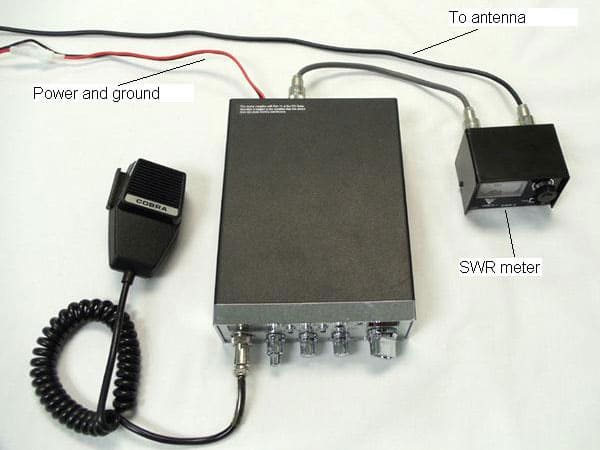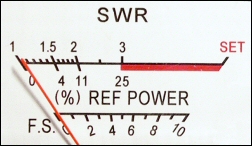Tuning a CB antenna requires nothing more than your installed radio, coax, antenna, and an SWR (Standing Wave Radio) meter. Start with selecting an appropriate location to do the tuning (open area), then move on to connecting the SWR meter. Then you’ll be ready to begin actually tuning the antenna with the step-by-step instructions that follow.
Choosing The SWR Testing Location
You’ll want to place your vehicle in an open area while tuning your CB antenna. Tuning the antenna while your vehicle is close to other vehicles, buildings, or even people can give you an incorrect reading. Also, each time you take a reading, make sure your doors, hood and windows are closed. If your antenna has a plastic cap on the tip, make sure that’s in place each time you take a reading.
How To Connect An External SWR Meter

Some CB Radios come with a built-in meter, like the Cobra 29 Classic. The owner’s manual will include step-by-step directions for the operation of the built-in meter.

If your CB radio doesn’t have a built-in SWR meter, you’ll need to get one. The popular AUSWR SWR meter is affordable and comes with the coax jumper cable you’ll need to connect the meter to your CB radio. If your SWR meter doesn’t come with a coax jumper cable, you’ll need to buy one.
A typical SWR connection to a CB radio will look similar to the picture above. The instructions further below in this article outline connecting an external SWR meter and tuning a CB antenna.
How To Tune The CB Antenna Using An External SWR Meter
- Turn your CB off and disconnect the antenna coax cable from the back of your radio.
- Connect the end of your antenna coax to the SWR meter where it indicates “antenna” or “ANT”. The connector inputs could be on the back and the labels on the front of the meter.
- Connect the short coax jumper cable coming from the transmitter position on the SWR meter to the back of the CB where you took off the coax cable in step 1.
- Close the hood and doors on your vehicle, and make sure there are no people or other large vehicles around the vehicle area.
- Turn on the CB.
- Set the CB to channel 40.
- Set the SWR meter to the FWD (forward) position.
- Key the microphone by depressing the talk button and turn knob until the SWR meter indicates the “set” position. Unkey the microphone by letting up on the talk button. Please note that many meters will have both an SWR and RF Power scale so be sure to read the SWR reading.
- Flip the SWR meter to the “REF” (reflect) position.
- Key the microphone and look at the SWR reading on the SWR meter for channel 40. Take note of that reading.
- Repeat steps 6 through 10, this time on channel 1.
- See SWR Range Explanations below. The lower the reading, the better your CB radio will perform. The goal is to set the antenna to the lowest SWR readings possible, evenly across the 40 channels- for example, the reading on channel 1 and 40 at the same at 1.5. By having the SWR readings match on channel 1 and 40, your radio will perform well on any of the channels within the 40 channel bandwidth. If they do not match, adjusting the antenna is advised.
IMPORTANT: If the meter reading is in the red zone, indicating HIGH SWR readings, DO NOT operate the CB. You could potentially damage your radio.
If the reading on channel 1 is higher than the reading on channel 40, your antenna system is TOO SHORT and you need to lengthen your antenna.
Example of when your antenna system is too short: If the SWR meter reading on channel 1 is 2.6 and the reading on channel 40 is 1.3, your antenna is too short. You will need to increase the physical length of the antenna system. Possible solutions include adding a spring or quick disconnect, raising the antenna, get longer coax (and just make sure to store any excess coax in a figure eight style, about a foot in length, and loosely bound in the center), or re-positioning the antenna.
Lengthening of the Firestik II and Firefly is accomplished by turning the tuning screw further out. Metal antennas require loosening the allen screws and raising the metal whip.
If the reading on channel 40 is higher than channel 1, your antenna system is TOO LONG and you need to shorten your antenna system.
Example of when your antenna system is too long: If the SWR meter reading on channel 1 is 1.2 and the reading on channel 40 is 2.3, your antenna is too long- you’ll need to shorten the antenna system to get better efficiency. You can do that by turning the tuning tip or the adjusting ring on your fiberglass antenna. With a metal antenna, you’ll have to loosen the Allen screw, remove the metal mast, trim about an 1/8-inch off, and place it back firmly against the coil or in the base.
SWR Range Explanations:
SWR 1.0-1.5: The ideal range! If your SWR is under 1.5, you’re in great shape. If you’re at 1.5 and really, really want to drop down to closer to 1 it’s likely possible to do with addition tuning, different equipment or a different mounting location. But the drop from 1.5 to 1.0 won’t make a substantial increase in performance. It’s not nearly as noticeable as, say, going from 2.0 down to 1.5.
SWR 1.5 – 1.9: There’s room for improvement, but SWR in this range should still provide adequate performance. Occasionally, due to installations or vehicle variables, it’s impossible to get SWR lower than than this. You should try to get it lower, but performance should still be acceptable in this range. If you’ve tuned the antenna, SWR in this range is likely an issue of a less-than-ideal mounting location for your vehicle and/or an antenna that isn’t ideal for the mounting location. To troubleshoot, see this article on problematic CB antenna mounting locations.
SWR 2.0 – 2.4: While not good, this likely won’t damage your radio with casual use. However, you should definitely try to improve it if you can. SWR in this range is usually caused by a poor antenna mounting location and/or a poor choice of equipment for your specific vehicle. To troubleshoot, you’ll likely need to move the mounting location and/or use a more suitable antenna. It’s by no means a good tuning job, but will function if you’ve exhausted all other troubleshooting possibilities.
SWR 2.5 – 2.9: Performance in this range will be noticeably decreased, and you might even damage your radio if you transmit frequently and for extended periods. We advise you not to operate your radio in this range. SWR in this range is usually caused by a poor mounting location and/or a poor choice of equipment for your specific vehicle. To troubleshoot, you’ll likely need to move the mounting location and/or use a more suitable antenna.
SWR 3.0+: Performance will be severely affected, and you’re likely to damage your radio with extended transmission use. You SHOULD NOT transmit with your CB at SWR levels above 3.0. If your SWR needle swings all the way to the right (off the charts) when getting your 3.0+ readings, you almost certainly have a major installation problem. This is almost always the result of a poor ground or incorrectly assembled stud, but on rare occasions can indicate a faulty coax, antenna, or incorrectly attached SWR meter.
